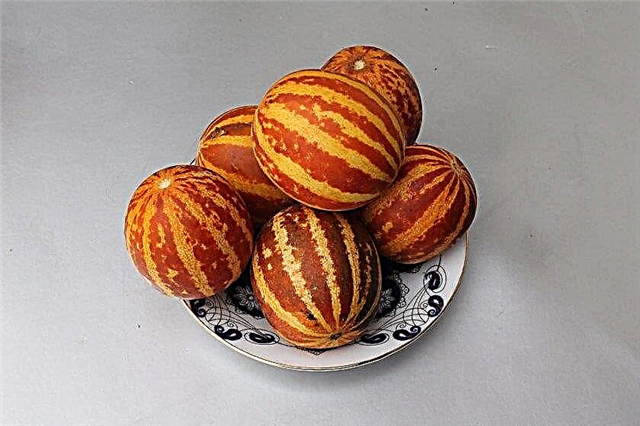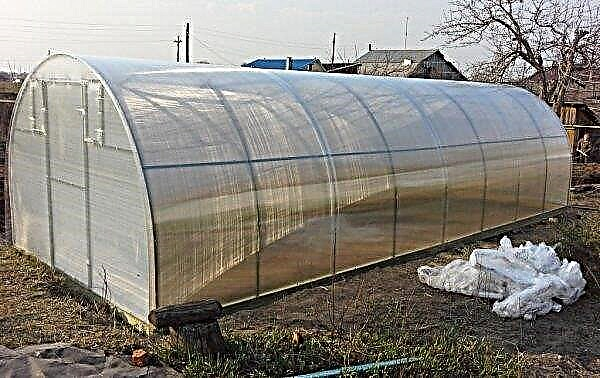Melon is rightfully considered one of the most popular and sought-after fruits, therefore, breeders have created many varieties that can satisfy the needs of the most sophisticated consumers. One of the most popular is the so-called Vietnamese melon (striped), characterized by a rich taste and delicate finish. From this article you will learn the main features of this variety, as well as get acquainted with the secrets of its successful cultivation.
Description of Varieties
Vietnamese melon is a type of common melon belonging to the pumpkin family. This plant was bred and most actively popularized in Asia, but in the last decade, fruit has been massively gaining loyal fans in other parts of the world.
This plant is distinguished not only by early maturity, but also by excellent taste and production qualities, which makes it possible to cultivate it in almost any climatic conditions.Did you know? One of the largest promoters of Vietnam melon is considered a famous politician and president of Vietnam, Ho Chi Minh. Thanks to him, the fruits of the plant began to be widely grown in the territory of Asia Minor.
There are several varieties of this melon. All of them are high-yielding fruit plants, characterized by uneven ornamentation of the peel of the fruit: as a rule, these are various spotted inclusions collected in whole or torn strips from the base to the apex. However, many gardeners still do not know what they are called, and what is a melon with a striped peel.
The following varieties are classified as Vietnamese melons:
- Gift of grandfather Ho Chi Minh - the most famous and common plant among the representatives of the group. It differs in fruits of saturated orange color with characteristic bright yellow stripes. It is grown in open ground, as well as in greenhouses, for home and industrial use. The fruits of the variety are small, weighing up to 250 g; they are characterized by a dense, moderately juicy, oily flesh with a rich taste and aroma. Often the plant is grown in trellises, in which case it can become an ideal decorative addition to the garden.

- Yan Jun - the variety is grown only in warm areas or in regions with a tropical and subtropical climate. At the same time, Yan Jun is characterized by large fruits, weighing up to 400 g, saturated yellow, with green or orange-green longitudinal stripes. The pulp of the variety is aromatic, elastic, with bright taste characteristics, as well as a light musky finish. The variety is resistant to a variety of diseases and specific pests.

- Melotria - The main distinguishing feature of the plant is the rich green color of the fruit with pale green stripes. In shape and size, they are a cross between a pumpkin and a cucumber, their length often does not exceed 4 cm, and their mass is 100 g. Many grow this plant as an ornamental, but its fruits are almost as good as other varieties of aroma and quality. In addition, in the root zone of this variety, so-called tubers are formed, which makes it a universal food plant used for sweet and salty dishes.

- Milk melon - one of the most exotic and rare varieties. Its fruits have an elongated shape, a small club-shaped circle is formed on the edge. The peel of the fruit is often cream tones, from the base to the edge are small folded furrow-like strips. A characteristic melon aroma is inherent in them, however, the fruits are often used as a universal additive not only to sweet, but also to salty dishes.

How to choose a melon when buying
By the end of the summer season, melon appears on sale en masse, but not many manage to get a successful fruit. This is often due to the fact that they break away from the bush still green, so that they can be safely transported over a long distance - however, because of this, immature melons often begin to deteriorate on the shelves, which begin to deteriorate even at the stage of incomplete maturity.
To protect yourself from low-quality melon, when buying, you must first of all evaluate the following:
- appearance - the peel should have a uniform color, without any putrefactive and other inclusions;
- pulp density - it should be soft, but springy, when pressed to restore shape;
- smell - a good melon should have a light and pleasant smell, without any impurities, including chemical nature;
- "Melon sound" - with a light palm strike on the surface of the fetus, it should make a slightly muffled, but distinct and clear sound, without any "watery echoes";
- place of sale - High-quality, as well as safe vegetables and fruits are often found only in large retail chains. It is forbidden to buy melon near motorways, as it is able to absorb toxins and heavy metals released during the combustion of fuel.
Important! Pink spots on the peel indicate preservative treatment of the fruit. Acquiring such instances is not recommended, since these substances are difficult to eliminate and also have a toxic effect on the body.
How to grow yourself in the garden
A small striped melon is the best choice for a modern gardener. All sorts of varieties of this plant due to the short growing season are able to bear fruit in almost any climatic conditions, therefore, even in the northern regions with a short summer, they can give a plentiful harvest. However, for this, the plant needs to create an optimal microclimate and appropriate conditions.
The timing
As one of the most prominent representatives of Pumpkin, melon loves warmth and mild weather conditions. Seeds begin to germinate at an average daily air temperature of about +18 ... + 20 ° С, however, they develop best at a temperature of about +22 ... 25 ° С.

At the same time, the soil microclimate is also important for the plant: the soil must necessarily warm up to at least + 18 ° C, otherwise the seeds will fall into a dormant phase, or even die. In the temperate climatic zone, such a period often begins at the turn of spring and summer, therefore, crops are sown from about the second half of May to mid-June.
Site selection
Melon likes well-lit and draft-protected areas, so it is best grown on the south side. At the same time, a sufficient amount of light is the main condition for successful cultivation, especially during flowering and the formation of the ovary. Therefore, they sow the plant away from tall vegetation, and only in spacious areas.
Important! Melon is planted in the same place no more than once every 4-5 years. Otherwise, this will adversely affect plant productivity and soil fertility.
Since all representatives of the culture are distinguished by a delicate root system with refined roots, striped melon is planted only on light soils. Such substrates must necessarily be well structured, drained and perfectly warmed up. It is best suited for this well-fertilized (peat, compost or humus) sand and sandy loam mixtures, so clay, loamy and other heavy soils necessarily facilitate river sand.

Important for this culture and predecessors. Melon grows best after a variety of herbs, grains and legumes, corn, tomatoes, potatoes, beets, carrots and onions. Do not plant it after cucumbers, squash, zucchini and other melons.
Sowing technology
Sow the culture with a groove or hole method. In the first case, the seeds are sown in common rows, in the second they are placed in individual wells. Regardless of the type of crops, there should be a distance of at least 70 cm between each plant, and the row spacing should be about 1–1.5 m. At the same time, the depth of the seeds should be within 4–6 cm.
Seeds are sown in groups of 4-5, after which no more than one, the most viable plant is left from these sprouts. This is due to the low germination of the seeds of the culture; Such a measure will make it possible to avoid uneven sowing of the site.
Thicken crops is not recommended - melon is quite demanding on free space, the lack of which often causes a sharp decrease in yield and quality of fruits. In addition, with an increase in the number of plants in the beds more than 2 pcs / m², cross-shading of the bushes is observed, which also does not have the best effect on the development of plants.
How to care in the open ground
In order to achieve high yield and good ripening from the melon, the beds need to be provided with daily care. Plants require high-quality watering, timely top dressing and soil care. Only in this case can a rich and healthy crop be grown.
Watering
Plantations are watered sparingly - the melon does not tolerate high humidity, which often leads to the defeat of beds by various fungi. To do this, the soil is irrigated only after a dense, dry crust appears on its surface, with a thickness of about 5-6 cm. Depending on the climatic zone of cultivation, the procedure is carried out once every 1-2 weeks.

For irrigation use only clean, well-settled water, pre-heated to +20 ... + 25 ° C. It is forbidden to water the planting with cold water, since in this case the plant may undergo hypothermia. Plantings are irrigated by sprinkling, while it is not recommended to moisten the green mass, therefore, a system of branched irrigation grooves is necessarily created on the beds.
Top dressing
Melon plantings should be fed 2-3 times during the growing season; a more intensive fertilizer system is prohibited, as it can lead to over-breeding of fruits.
The procedure is based on the following scheme:
- first feeding spend 1-2 weeks after seed emergence. To do this, use complex mineral fertilizers based on nitrogen compounds (Kemira, Kristalon, ammonium nitrate);
- second implantation beds are made during budding, using a variety of liquid organic fertilizers. The most commonly used solution is mullein (1:10) or chicken droppings (1:15);
- last feeding perform during the active growth of the ovaries, for this use phosphate and potassium mixtures (superphosphate and potassium nitrate).
Did you know? The most expensive variety of melon is the Yubari King variety, it is grown in the small town of Yubari (Japan). The fruits of the plant are sold at a special auction, and their price can reach up to 20 thousand US dollars.
Bushes
Among many gardeners, there is an opinion that forming a bush for pumpkin is an unnecessary waste of time and effort. However, without this procedure it will not be easy to achieve high crop yields. Periodic pruning of bushes eliminates useless growth points and excess shoots on plants. Correctly formed bushes to the maximum direct substances removed from the soil to the formation of fruits, which favorably affects their size, weight and aromatic qualities.

They begin to shorten the plant after the main stem enters the phase of 3-4 leaves - pinch the top on it, which stops the horse growth of the shoots. In addition to the main thing, 2 of the most powerful shoots are left on the bush, which in the future will become the basis for the development of the ovary. They are pinched a little later, after the growth of 4-5 sheets. In the future, such a structure of the bush is maintained until the fruit is poured.
Soil care
Weeding and loosening of melon plantings is carried out regularly. Often, these procedures are combined, which helps to reduce the total labor costs when caring for plantations, as well as create the necessary microclimate in the soil. The soil is treated once a week, to a depth of not more than 12 cm.
The root system of pumpkin lies in the upper layers of the soil, so loosening the soil at lower horizons will damage the delicate root system of the bush. Careful soil care is carried out throughout the growing season, up to the fruit, after which weeding and loosening often do not give the desired effect.
Harvesting
Melon harvesting, depending on the climate of the growing region, is carried out 40–65 days after the appearance of the first seedlings; often this period begins no earlier than the end of summer, however, it is impossible to precisely determine the calendar dates for the full maturity of the crop. The ripening of melons is influenced by many different factors, including the microclimate, as well as the systematic and effective care of the beds, so each fetus is examined individually.

You can determine the full maturity of a melon thanks to the following features:
- smell - ripe fruit has a characteristic sweetish aroma;
- skin color - ripe melon always has a rich and vibrant hue;
- faded stalk - this indicates the end of the fruit filling phase, which always means full maturity;
- pulp condition - ripe melons are always distinguished by soft, but elastic flesh.
After harvesting, the melon is often stored for a month, but often these dates are very conditional. Even when fruits are stored in the refrigerator, after 2 weeks they begin to sharply lose their taste, and by the 4th week after harvesting they become practically unusable. Therefore, the melon is often subjected to all kinds of culinary treatments after collection, extending its shelf life.
Pulp can be one of the main ingredients for cooking:
- compotes;
- confiture;
- jam;
- jam;
- jams;
- all kinds of fruit platter;
- caramelized spins.

Vietnamese melon is an exotic early ripe variety, attracting not only the taste characteristics of the fruit, but also their miniature size. Such features make it possible to grow crops in any climatic conditions, even in areas with limited space. When sowing striped melon, it is imperative to remember that this plant is heat-loving and does not tolerate drafts, so the choice of a site for sowing should be approached no less carefully than the care of the beds.
















